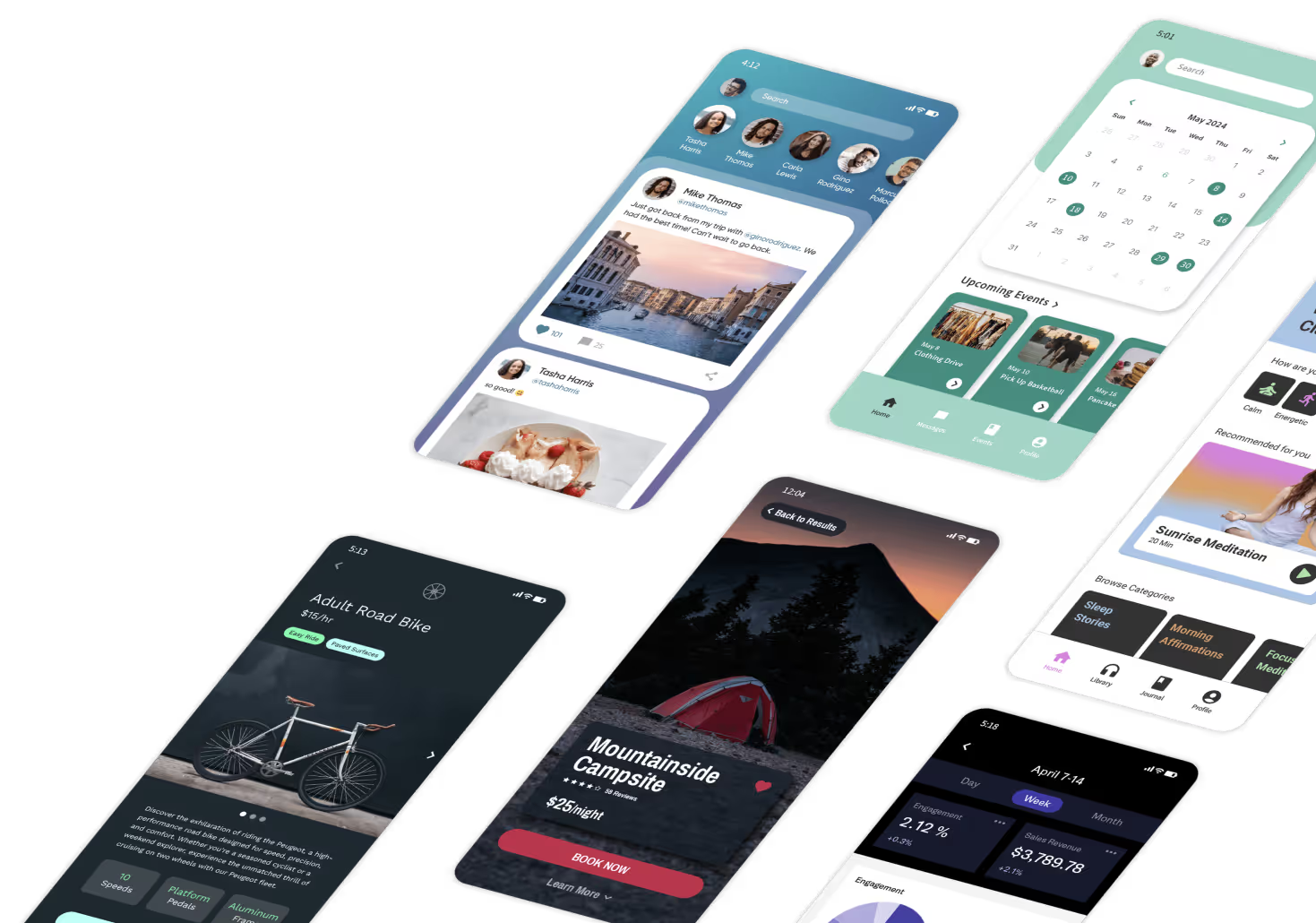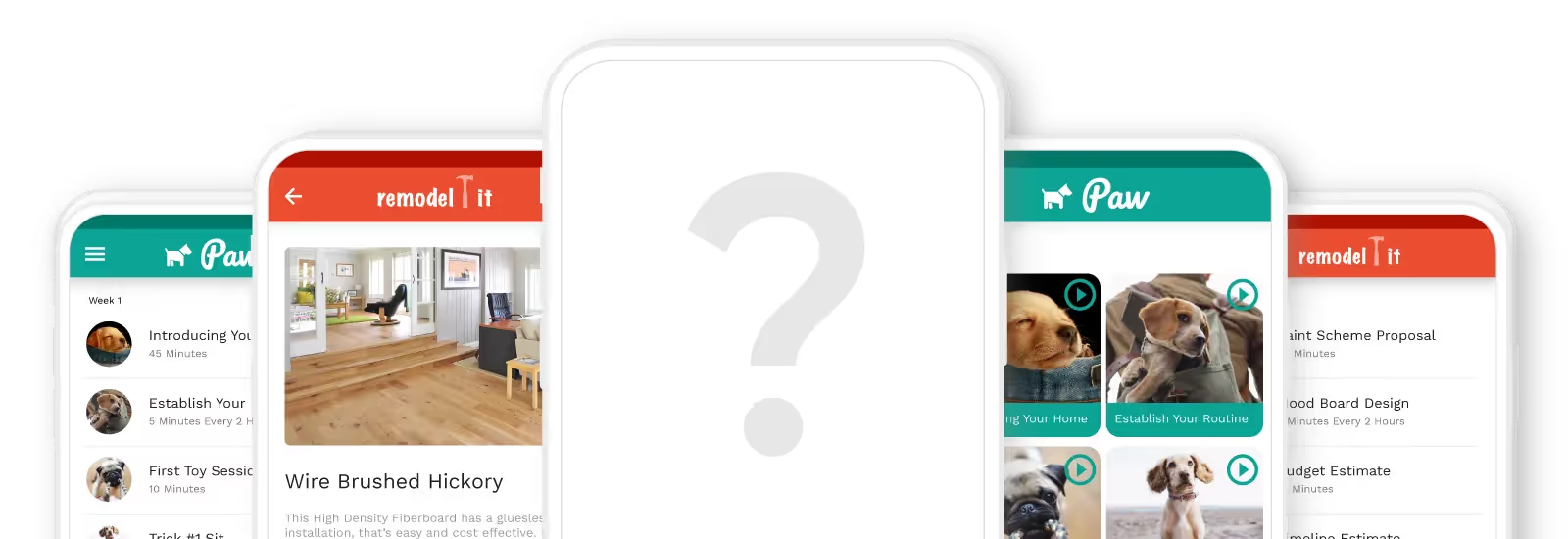.avif)
Ever wondered if low-code development could help your business succeed? It certainly can, whether you're in e-commerce or education.
Low-code platforms offer flexible, cost-effective solutions for building apps without deep technical know-how.
Read on to learn:
- Intro to low-code and how it works
- Industries benefitting from low-code
- 14 low-code app use cases
- Benefits of low-code
- Getting started with a no-code tool for free
Let’s now briefly discuss low-code app development.
What Is Low-Code App Development?
Low-code app development is an app-creation process that uses a blend of no-code functionalities and tools that require some technical skill. For instance, low-code and no-code app builders feature a drag-and-drop interface for quick and easy frontend construction.
However, low-code app builders require more knowledge to develop a backend and database. You’ll need to know how to structure your database schema, be familiar with SQL (structured query language), and understand APIs. Unfortunately, a lack of experience with tech will probably result in frustration.
Many low-code platforms also come with other techie-friendly perks, such as the ability to patch in your own JavaScript or Python code to build out unique frontend features, permission to keep your app’s source code for further development with a programming language, and others.
While only the tech-experienced can reap low-code benefits, it applies to many industries.
Industries Benefiting the Most from Low-Code Development
Low-code app development applies to most business sectors and industries in various ways. Here’s a list of some industries and how they can benefit from using low-code:
- Healthcare: Many low-code platforms are HIPAA-compliant, allowing you to build apps for patient management, appointment scheduling, record-keeping, and more.
Simplify workflows for medical staff with automated task management tools.
- Finance: Create customized and secure apps for payments, reporting, customer onboarding, cost and taxation analysis, and fraud detection.
- E-Commerce: Build an e-commerce platform to bring your products to the world and enable payment processing and customer service. Create loyalty programs, discount codes, and more.
- Manufacturing: Build apps to schedule production scheduling, monitor inventory control, and maintain equipment. Monitor your metrics in real time using APIs and IoT integrations.
- Logistics and Supply Chain: Create real-time shipment tracking tools, optimize delivery routes, and create portals for vendor management.
- Education: Develop platforms for virtual classrooms and student portals to submit work and more. Automate redundant administration tasks like grading, attendance, and communication.
- Real Estate: Automate property management tasks, like tenant screening, lease renewals, and rent payments. Build permissions-based portals for buyers, sellers, renters, owners, and agents. Integrate with mainstream platforms like Zillow and Redfin.
- Hospitality and Travel: Simplify booking processes, manage properties, and handle customer queries and communication.
- Professional Services: Build apps for project management, consulting, contracting, legal, and other services. Offer tailored advice without eye-watering IT investments.
14 Low-Code Use Cases To Get Inspired To Build Real-World Apps
While many low-code platforms are flexible enough to tailor-make almost any app, here are 14 apps you can create to organize your business processes, help bolster your bottom line, or execute tasks.
#1. Customer Relationship Management (CRM) Tools
Do you need to manage and record customer interactions or build a system to organize customer records? Consider using a low-code platform to develop your own customer relationship management tool.
With a low-code platform, you can rapidly develop and deploy your CRM app for tracking sales, connecting to representatives, storing and referencing client data, and more.
For inspiration, check out the client-insurance portal built by insurance behemoth AXA with the low-code platform OutSystems. This tool enables AXA’s expansive network of brokers to find and reference client data for claims more quickly.
#2. Onboarding Systems
If your company, website, or organization needs to vet and analyze a large number of applications, building your own low-code onboarding system can ease your workload. You can program your app to evaluate applications automatically, saving you loads of time and effort.
Build custom components that screen for specific attributes, such as years of experience, work completed, and more. Pepper Content did just that, using the low-code platform Retool to an app to onboard top talent to execute content writing, translation, and design tasks.
#3. Inventory Management Tools
Streamline your inventory management to your own needs. Your app can automate stock level monitoring, instantly updating in real time across platforms whenever sales are made, or stock is received. This real-time data helps avoid overstocking and stockouts, ensuring optimal inventory levels.
#4. Patient Management Apps
These applications can consolidate patient records into a unified system, allowing you and your team quick access to medical history, treatment plans, and appointment schedules. This will help ensure your medical team is 100% informed about each patient’s unique needs and medical history.
These apps also automate routine tasks like appointment scheduling and sending patient notifications, reducing paperwork — everyone loves less paperwork. It’s important to note that you’ll need a HIPAA-compliant backend to store sensitive medical data.
Enna Health App is the first HIPAA-compliant app built with Draftbit, and it provides medical professionals with up-to-date info and more about their patients so they can receive ideal care.
#5. Financial Data Dashboards
Get quick, real-time access to tables and graphs of your company's financial metrics and trends. Leverage these when deciding to purchase new products or services, pitch investors, and more.
Financial dashboards also automatically generate financial reports, reducing the time and effort required by the finance team. You can also plug in predictive analytics to make educated decisions about revenue projections, vendor costs, etc.
#6. E-Commerce Stores
Because low-code platforms allow for rapid app development, you can launch online stores with customizable product listings and payment integrations quickly. This means you can get your products in front of more folks faster than your competitors.
Most low-code platforms also feature e-commerce functionalities such as payment integrations, inventory management tools, and connections with shipping services. This means you can execute all your e-commerce tasks in one simple, streamlined place.
#7. Marketing Platforms
One handy low-code use case is creating a marketing platform to automate email and social media scheduling workflows. Doing this can help your teams quickly launch, test, and refine campaigns based on real-time data and customer feedback.
You’ll also be able to create metrics that track each campaign’s success. This will allow you to learn what works and doesn’t, refining and improving your approach for the next campaign.
#8. Government Apps
You can create apps to simplify citizens' access to public services. These can provide real-time updates on public transportation's whereabouts, allow people to pay for services directly from an app, send emergency notices during natural disasters, and more.
Additionally, you can build an app that simplifies and speeds up license application processes for businesses, services, and others. This will most result in citizens having a more positive mental attitude and could bolster local economies.
The City of Rotterdam in The Netherlands built several public service apps using Mendix, a popular low-code app builder.
#9. Project Management Applications
Streamline your company’s complex project tracking from inception to completion. These apps provide real-time collaboration between team members, ensuring everyone stays informed and can react to changes quickly.
You can also grant role-based permissions for certain parts of the app to ensure sensitive data remains locked down.
Automate workflows or specific processes in the project management stages to reduce manual entry errors and save time. Visualize all the data you generate and the progress made through timelines, Gantt charts, and other visualization tools.
#10. Real Estate Property Management Tools
High-level real estate management can involve painstaking redundant tasks. A real estate management app can alleviate much of this pain through automation. You can automate tenant screening, lease applications, and payment receptions.
A low-code-made real estate app can save tons of time and let you focus more on hustling and maintaining your properties. You can communicate with tenets and send them push notifications about routine maintenance or anything else.
#11. Travel Apps
Create a customized travel booking platform tailored to niche markets and your customers’ preferences. This will allow you to serve your customers better while gathering information about and adapting to their evolving needs every time they use your app.
This adaptability ensures you can quickly respond to the latest travel trends or regulatory changes (luggage-size limits, etc.) without requiring extensive redevelopment. And, of course, let your customers book flights, hotels, or your curated travel services.
#12. Education Apps
Ideal for educators of every stripe, educational apps can bolster students' learning by streamlining the deployment of educational material like class notes, study guides, quizzes, and more. This provides one easy-to-reach place for your students to learn, and your app will organize all your work for you.
A great educational app is the City as a School app, which is made with the low-code tool Draftbit. It lets students map out their career pathways and cater an educational plan, providing access to several resources.
#13. HR Management Systems
Creating an HR management system using low-code builders will allow you to automate many repetitive HR-related tasks, such as scheduling, payroll, and more. To ensure your team is current on the latest standards and practices, create training materials they can access directly from your app.
#14. Supply Chain Management Tools
Building your own supply chain management app can make life easy if your business deals with shipping or international trade. Plug an API into your shipping accounts to track your goods in real time, manage vendors, and optimize logistics.
Then, collect data about each shipment to optimize your operations moving forward and avoid dreaded bottlenecks. This can also help you determine which shippers are the most cost-efficient, presenting you with better, more cost-effective solutions in the future.
Low-Code Benefits
Now that you know quite a few actual tools and apps you can create using a low-code platform, you might ask yourself, “What are some benefits of using low-code tools?”
Here are some of the reasons folks go with a low-code app builder:
- Customization: Whether your low-code use case is for a credit union, roofing company, or large restaurant chain, you’ll have tons of customization control over how our app looks, functions, and feels.
Plus, low-code tools allow you to dial in your own particular backend logic and patch in unique frontend widgets and other features, ensuring your app stands out.
- Cost-effective: Hiring a developer to build your app can cost an arm and a leg — and sometimes over $120,000. Low-code app builders usually cost a fraction of this, depending on your app’s size or scope.
Using a low-code tool, you can build an app for a small or medium-sized business for around $50/month (billed monthly) and in the $100s for a larger-scale project.
- Easy to update: When you develop an app on the low-code platform, it’s yours. You’ve got the keys to the castle, meaning you can change or update any part of your app whenever you wish. You won’t need to communicate with a developer, wait for the updates, and hope the final product turns out right.
'{{rich-cta}}'
Next Steps: Try Adalo, a Simple No-Code Platform
Not a techie but still want to create your own app? Fear not and get Adalo.
Adalo is a no-code app builder that provides a delightful balance between power and simplicity. And unlike most low-code app builders, you won’t need to worry about having any tech skills to use Adalo — it’s easy enough to start using immediately after creating an account.
You can customize your app to your precise needs and wants — adjust the color, change the layout, and integrate with platforms like Stripe and Zapier for more oomph. When you finish building your app, publish it on the web, the Apple App Store, and the Google Play Store to get it in front of an enormous audience.














